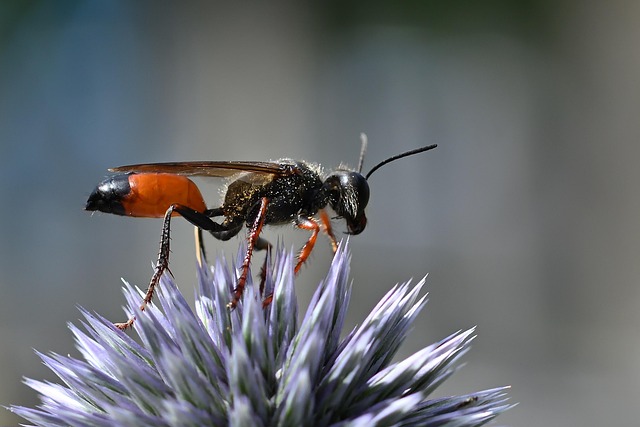Wasp behavior, driven by social nature and colony dynamics, heavily influences their attraction to properties. Regular inspections, emphasized by professional wasp removal services, are critical for early nest detection. Proactive measures like sealing entry points, maintaining cleanliness, promptly addressing food waste, and ensuring proper ventilation can deter wasps from nesting. These strategies reduce the need for frequent professional interventions, creating safer living spaces. Timely intervention through professional services is crucial for preventing structural damage. A strategic approach combining proactive measures and swift action, with seasonal checks in spring and summer, ensures long-term wasp control. Engaging professionals and maintaining good hygiene are key to promoting a safe environment.
Keeping your property wasp-free is essential for safety and comfort. This comprehensive guide delves into effective strategies for managing wasps, focusing on proactive maintenance plans. We explore how understanding wasp behavior and their attraction to properties is key to prevention. Regular inspections play a vital role in identifying potential nests early. Learn about the best practices for professional wasp removal and creating a tailored maintenance regimen for long-term protection against these pesky intruders.
Understanding Wasp Behavior and Their Attraction to Properties
Wasp behavior plays a significant role in their attraction to properties, and understanding this is crucial for effective maintenance plans. These insects are highly social creatures that live in colonies with a queen as the leader. They build nests, typically in hidden areas like attics, eaves, or trees, and defend them aggressively if threatened. Wasps are attracted to properties by sources of food, water, and suitable nesting sites. Common attractions include ripe fruits, sweet substances (like those left behind from outdoor dining), and open containers with liquid.
Professional wasp removal services emphasize the importance of regular inspections to identify nest locations early. By understanding wasp behavior, property owners can take proactive measures. This includes sealing entry points, maintaining a clean environment, promptly addressing food waste, and ensuring proper ventilation. These strategies help deter wasps from establishing nests and reduce the need for frequent professional interventions, ultimately creating a safer and more comfortable living space.
The Importance of Regular Inspections in Wasp Prevention
Regular inspections are a cornerstone of any comprehensive wasp prevention strategy. They allow for the early detection of wasp nests, which is crucial for effective and safe removal. Professional wasp removal services often emphasize this aspect, as it prevents potential hazards associated with large or inaccessible nests. By conducting routine checks, especially during spring and summer when wasps are most active, property owners can mitigate risks to themselves and their neighbors.
These inspections should cover all potential entry points, such as gaps in walls, attics, and windows. Trained professionals use advanced techniques to identify even the smallest signs of wasp activity, ensuring no nest goes unnoticed. Timely intervention through professional wasp removal services is key to maintaining a safe environment and avoiding costly damage that wasps can cause to structures over time.
Effective Strategies for Wasp Control and Removal
Wasp control and removal should be approached with a combination of proactive measures and prompt action. Regular inspections are key to identifying potential wasp nests early on. Professionals recommend scheduling periodic assessments, especially during spring and summer when activity peaks. Early detection allows for more targeted and effective treatment options.
For effective professional wasp removal, it’s crucial to employ a multi-pronged strategy. This includes sealing entry points to prevent new infestations, applying targeted pesticides, and safely removing existing nests. Trained professionals utilize specialized equipment and eco-friendly products to ensure the safety of residents and the environment. Regular maintenance plans, tailored to specific property needs, can greatly reduce wasp presence and provide long-lasting protection.
Creating a Comprehensive Maintenance Plan for Long-Term Protection
Developing a comprehensive maintenance plan is key to ensuring long-term protection against wasps and other pests. This strategic approach involves regular inspections, proactive measures, and immediate response to any signs of infestation. A professional wasp removal service can play a pivotal role in this process by providing expert knowledge and tailored solutions.
The plan should include seasonal checks, especially during spring and summer when wasp activity peaks. Treating potential nesting sites and removing any food sources that might attract them is essential. Additionally, maintaining good hygiene practices and sealing entry points can deter wasps from entering properties. Regular maintenance not only prevents infestations but also promotes a safe and comfortable living environment.
Implementing a structured maintenance plan, including regular inspections and effective control strategies, is key to ensuring wasp-free properties. By understanding these insects’ behavior and attraction to human habitats, professionals can devise tailored solutions for long-term protection. Regularly scheduled checks allow for early detection of wasp nests, while efficient removal methods prevent future infestations. With the right approach, maintaining a wasp-free environment becomes achievable, providing residents with peace of mind and safe living spaces. For professional wasp removal services and comprehensive maintenance plans, contact specialized experts to safeguard your property year-round.
